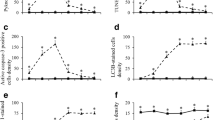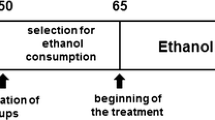Abstract
In cerebellar granule cells a rapid necrotic cell death has been observed during and immediately after glutamate exposure, followed by a delayed apoptotic type of neuronal death in a subpopulation of the surviving neurons. In some experimental models the DNA fragmentation characteristic of apoptosis is readily detected. In other systems apoptosis may occur only in a limited number of cells, rendering DNA fragmentation undetectable using conventional DNA-staining techniques (e.g., ethidium bromide). We have used a sensitive and non-radioactive method for labeling, detection, and quantification of high molecular weight (HMW) DNA fragments. This method is based on the introduction of thymine dimers into DNA after separation by pulse field gel electrophoresis, followed by detection with thymine dimer specific antibodies. Applying this method to cerebellar granule cells in culture, we detected an increase in the amount of HMW DNA fragments characteristic of apoptosis as early as 4 h after glutamate exposure. The N-methyl-D-aspartic acid (NMDA)-receptor antagonist MK801 protected against the fragmentation, whereas no protection was observed using the non-NMDA-receptor antagonist CNQX.
Similar content being viewed by others
References
Ankarcrona M, Dypbukt JM, Bonfoco E, Zhivotovsky B, Orrenius S, Lipton SA, Nicotera P (1995) Glutamate-induced neuronal death: a succession of necrosis and apoptosis depending on mitochondrial function. Neuron 15:961–973
Berman FW, Murray TF (1997) Domoic acid neurotoxicity in cultured cerebellar granule neurons is mediated predominantly by NMDA receptors that are activated as a consequence of excitatory amino acid release. J Neurochem 96:693–703
Bonfoco E, Krainc D, Ankarcrona M, Nicotera P, Lipton SA (1995) Apoptosis and necrosis: two distinct events induced, respectively, by mild and intense insults with N-methyl-d-aspartate or nitric oxide/superoxide in cortical cell cultures. Proc Natl Acad Sci U S A 92:7162–7166
Choi DW (1988) Glutamate neurotoxicity and diseases of the nervous system. Neuron 1:623–634
Ciani E, Grøneng L, Voltattorni M, Rolseth V, Contestabile A, Paulsen RE (1996) Inhibition of free radical production or free radical scavenging protects from the excitotoxic cell death mediated by glutamate in cultures of cerebellar granule neurons. Brain Res 728:1–6
Filippovich IV, Sorokina NI, Robillard N, Chatal J-F (1997) Radiation-induced apoptosis in human ovarian carcinoma cells growing as a monolayer and as multicell spheroids. Int J Cancer 72:851–859
Gallo V, Ciotti MT, Coletti A, Aloisi F, Levi G (1982) Selective release of glutamate from cerebellar granule cells differentiating in culture. Proc Natl Acad Sci U S A 79:7919–7923
Kerr JFR, Wyllie AH, Currie AR (1972) Apoptosis: a basic biological phenomenon with wide-ranging implications in tissue kinetics. Br J Cancer 26:239–257
Komuro H, Rakic P (1993) Modulation of neuronal migration by NMDA receptors. Science 260:95–97
Marvik OJ, Isaksen ML, Roza L, Lindqvist BH (1997) Photo-immunodetection: a nonradioactive labeling and detection method for DNA. Biotechniques 23:892–896
Orrenius S, McCabe MJ Jr, Nicotera P (1992) Ca2+-dependent mechanisms of cytotoxicity and programmed cell death. Toxicol Lett 64/65:357–364
Rabacchi S, Bailly Y, Delhaye-Bouchaud N, Mariani J (1992) Involvement of the N-methyl-d-aspartate (NMDA) receptor in synapse elimination during cerebellar development. Science 256:1823–1825
Roza L, van der Wulp KJM, MacFarlane SJ, Lohman PHM, Baan RA (1988) Detection of cyclobutane thymine dimers in DNA of human cells with monoclonal antibodies raised against a thymine dimer-containing tetranucleotide. Photochem Photobiol 48:627–633
Rusnak JM, Calmels TPG, Hoyt DG, Kondo Y, Yalowich JC, Lazo JS (1996) Genesis of discrete higher order DNA fragments in apoptotic human prostatic carcinoma cells. Mol Pharmacol 49:244–252
Thompson CB (1995) Apoptosis in the pathogenesis and treatment of disease. Science 267:1456–1462
Walker PR, Sikorska M (1997) New aspects of the mechanism of DNA fragmentation in apoptosis. Biochem Cell Biol 75:287–299
Walker PR, Weaver VM, Lach B, Leblanc J, Sikorska M (1994) Endonuclease activities associated with high molecular weight and internucleosomal DNA fragmentation in apoptosis. Exp Cell Res 213:100–106
Wyllie AH (1980) Glucocorticoid-induced thymocyte apoptosis is associated with endogenous endonuclease activation. Nature 284:555–556
Wyllie AH, Morris RG, Smith AL, Dunlop D (1984) Chromatin cleavage in apoptosis: association with condensed chromatin morphology and dependence on macromolecular synthesis. J Pathol 142:67–77
Author information
Authors and Affiliations
Corresponding author
Additional information
Published online: 30 August 2000
Rights and permissions
About this article
Cite this article
Slagsvold, H.H., Marvik, O.J., Eidem, G. et al. Detection of high molecular weight DNA fragments characteristic of early stage apoptosis in cerebellar granule cells exposed to glutamate. Exp Brain Res 135, 173–178 (2000). https://doi.org/10.1007/s002210000521
Received:
Accepted:
Issue Date:
DOI: https://doi.org/10.1007/s002210000521




